The Essential Role of Mortuary Freezers in Funeral Services
Find the essential role of mortuary freezers in preserving bodies for funeral services and the legal considerations surrounding them. Learn more now! These specialized refrigeration units serve as critical tools in the funeral industry, providing dignity and time during the sensitive period between death and final disposition.
Quick Answer: Mortuary Freezer Essentials
| Purpose | Specifications | Legal Requirements | Preservation Time |
|---|---|---|---|
| Slow decomposition | Temperature: 2-8°C standard, -2 to -30°C forensic | Death certificate required | 24-48 hours standard |
| Allow viewing for families | Size: Typically 7×4×3 feet | NOC from police (in many regions) | 4-6 weeks refrigerated |
| Support religious practices | Weight: 80-100kg | Compliance with local health codes | Months to years frozen |
| Provide time for funeral arrangements | Materials: Stainless steel, glass tops | Human Tissue Authority regulations (UK) | Varies by temperature |
When a loved one passes away, providing dignified care becomes paramount. Mortuary freezers play a crucial role by creating a controlled environment that significantly slows decomposition. This gives families the precious gift of time – allowing for travel arrangements, religious ceremonies, and proper farewells without the pressure of immediate disposition.
Unlike traditional embalming which uses chemicals, mortuary freezers offer a non-invasive preservation option that respects both cultural preferences and environmental concerns. These specialized units maintain precise temperatures between 2°C and 8°C (36-46°F) for standard preservation, while forensic-grade freezers can reach -30°C for extended storage.
Modern mortuary freezers come in various configurations, from single-body portable units to walk-in chambers capable of storing multiple remains. Many feature glass viewing tops to facilitate family viewings while maintaining the appropriate preservation environment.
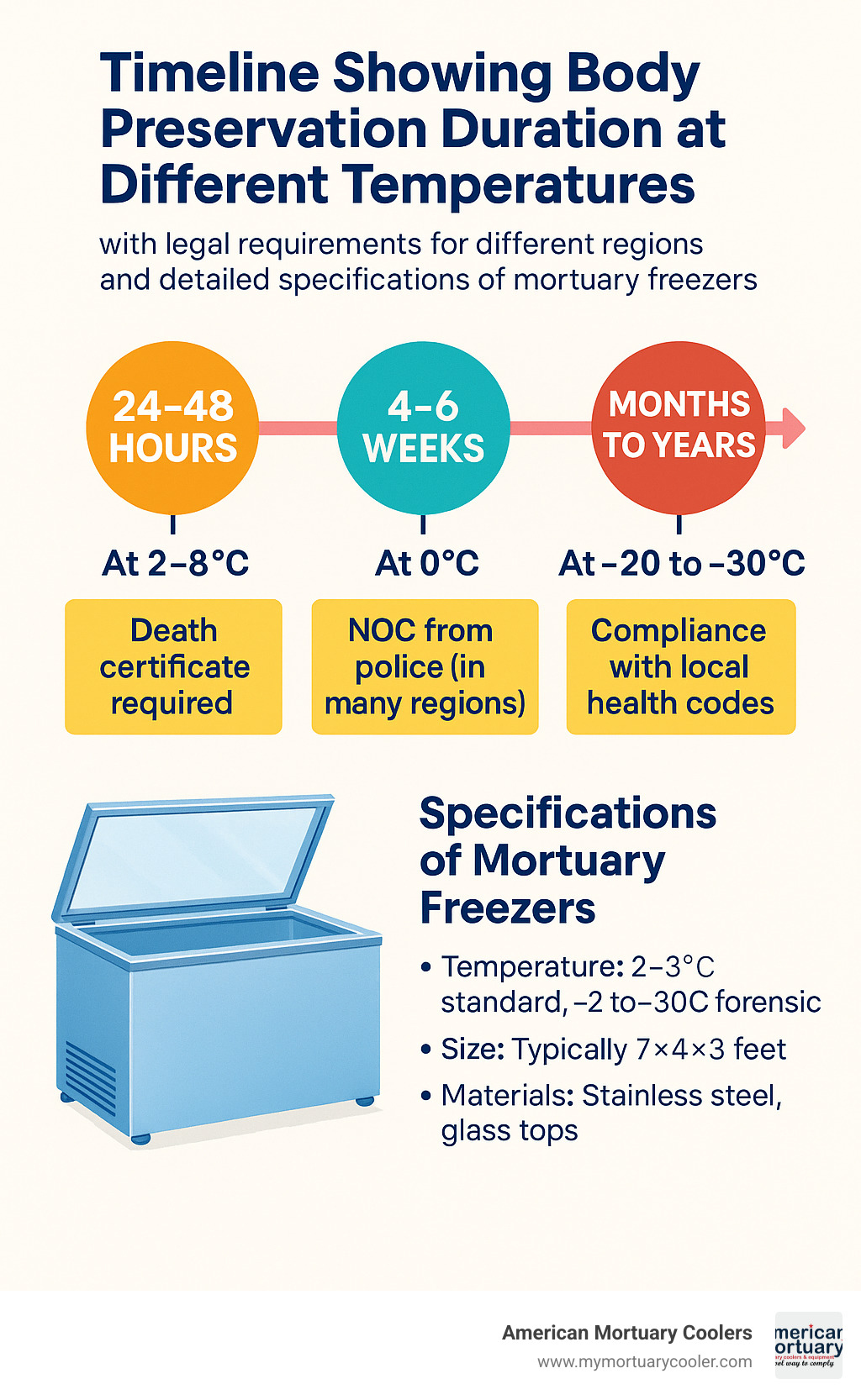
How Mortuary Freezers Work: Technology, Temperature & Timeframes
Mortuary freezers operate on the same fundamental refrigeration principles as commercial refrigerators but are specifically designed for the preservation of human remains. Understanding how these specialized units work helps funeral professionals make informed decisions about their preservation methods.
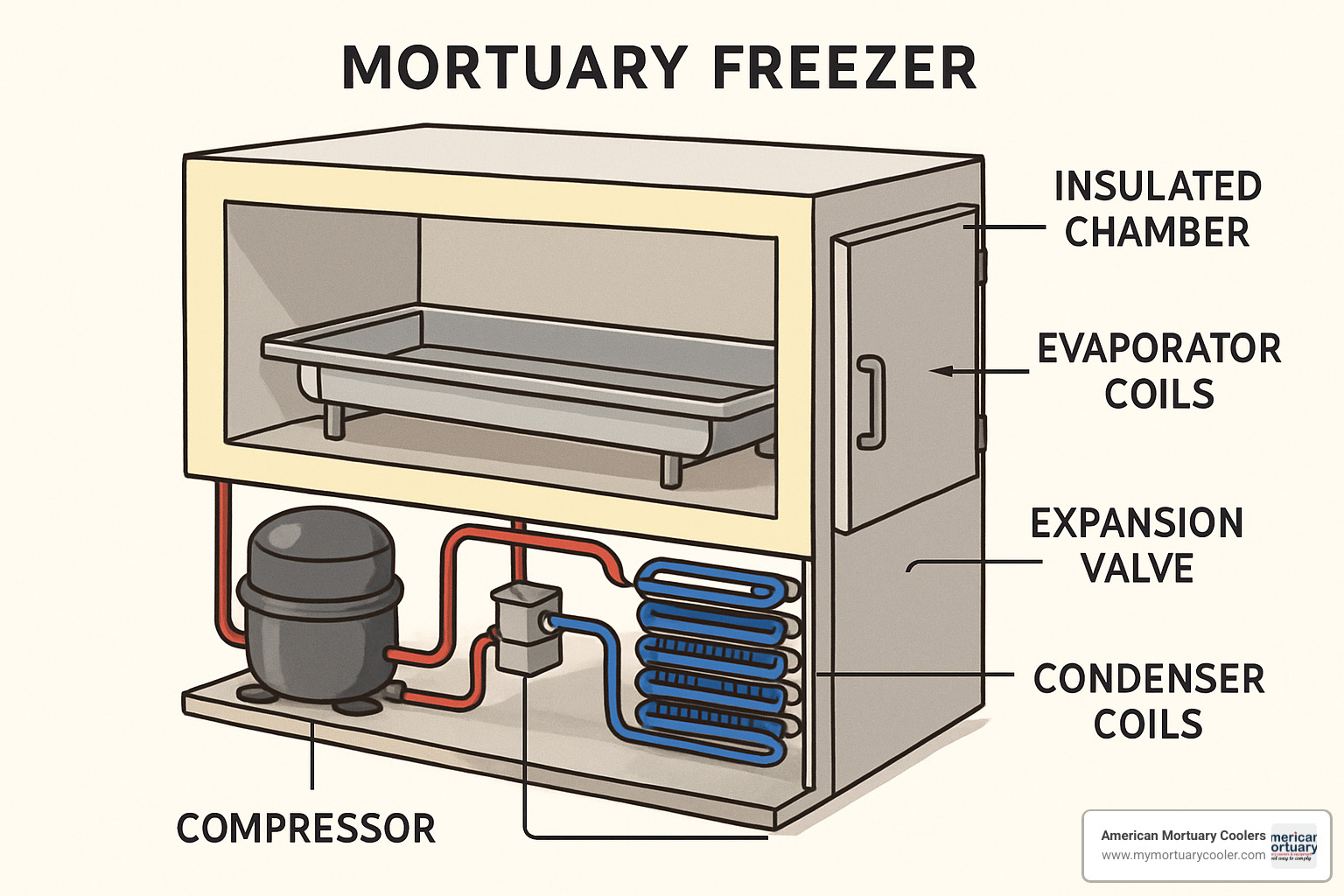
Inside a mortuary freezer, a carefully orchestrated process maintains optimal preservation conditions. The compressor pumps refrigerant gas under pressure, warming it up. This heated gas travels through condenser coils where it releases heat and transforms into a liquid. As this liquid passes through an expansion valve, the pressure drops suddenly, and the temperature plummets. The now super-cold refrigerant flows through evaporator coils inside the chamber, absorbing heat from the interior. The cycle repeats continuously, maintaining the perfect temperature to pause natural processes.
Key Components & Technical Specs
The backbone of quality mortuary freezers is the commercial-grade compressor designed for years of continuous operation. Cabinets are wrapped in high-density polyurethane foam between 60-80mm thick, with R-values of 32-43 that provide excellent insulation.
Digital thermostats maintain temperatures within a single degree of the setpoint, ensuring consistent preservation. The interior is crafted from seamless 304-grade stainless steel that resists corrosion and facilitates thorough sanitization. Many units feature glass viewing tops, allowing families to see their loved one without disturbing the preservation environment. Battery backup or generator connections ensure continued operation during power outages.
Optimal Temperature Ranges & Holding Times
Standard refrigeration (2°C to 8°C or 36°F to 46°F) slows bacterial growth dramatically while enzymatic activity drops by half. This gentle cooling preserves viewable features while giving families time for arrangements, typically 24-48 hours up to several weeks.
For medium-term needs, mild freezing (-5°C to 0°C or 23°F to 32°F) provides extended preservation of 1-3 months while minimizing tissue changes.
Forensic cases may require deep freezing (-10°C to -30°C or 14°F to -22°F). At these temperatures, biological processes essentially stop, allowing preservation for months or even years—though appearance will naturally change as tissues freeze.
How Long Can a Body Stay Preserved?
Preservation time depends on several factors: temperature setting, how quickly refrigeration begins after death, the person's condition before death, and environmental conditions within the freezer.
In standard coolers (2-8°C), families can typically expect 4-6 weeks of viewable preservation. Freezer units (-10°C to -30°C) can extend this timeframe to months or longer, though freezing affects appearance over time.
Most states don't permit indefinite storage without specific permissions and documentation from the family. According to scientific research on autopsy storage, bodies still provide valuable forensic information after extended refrigeration, though certain biochemical markers naturally degrade over time even at low temperatures.
Find the Essential Role of Mortuary Freezers in Preserving Bodies for Funeral Services and the Legal Considerations Surrounding Them
Find the essential role of mortuary freezers in preserving bodies for funeral services and the legal considerations surrounding them. Learn more now! as we explore how these specialized units do far more than simply preserve remains—they create space for healing and honoring traditions during difficult times.
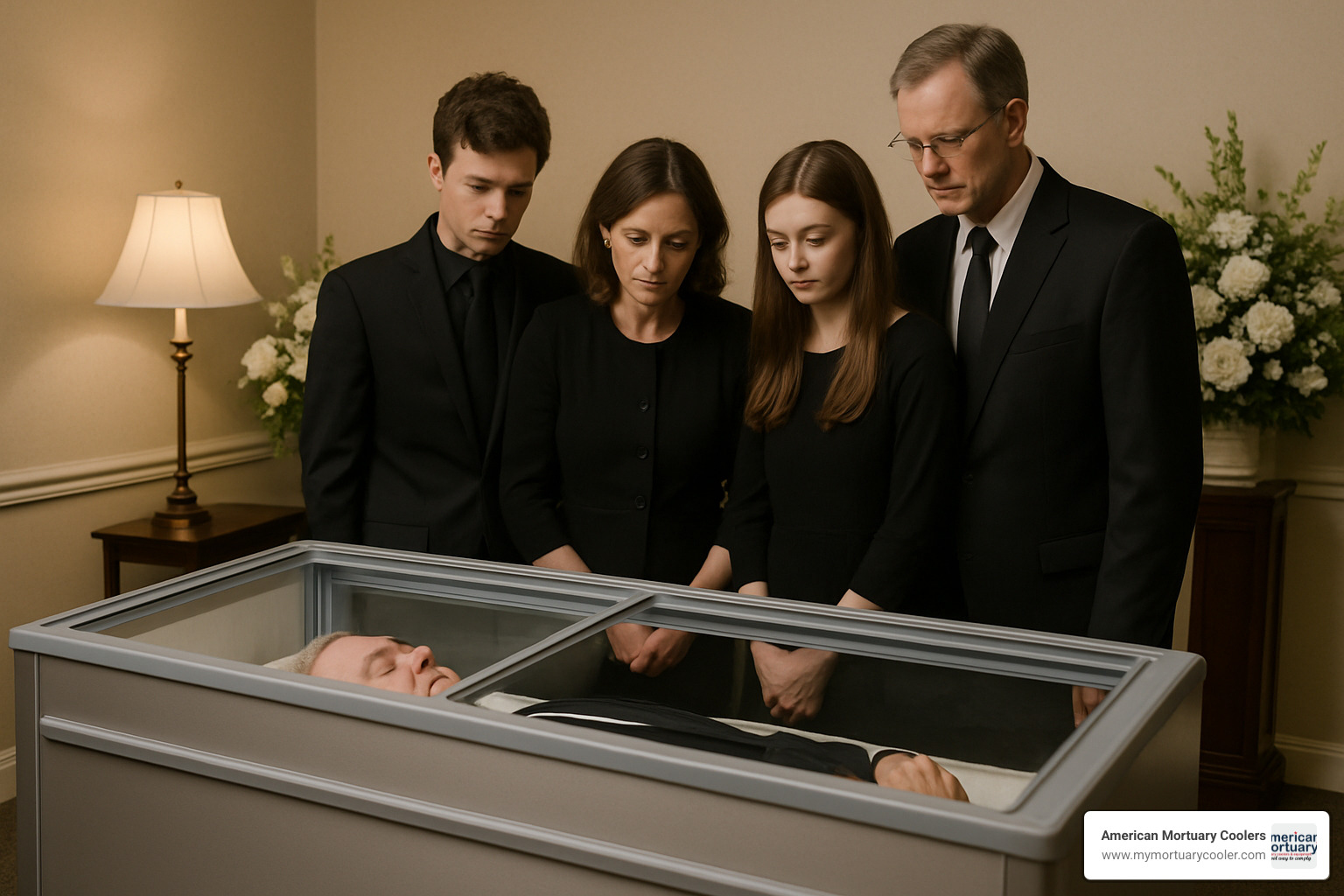
When a family loses someone dear, time becomes precious in unexpected ways. Mortuary freezers provide that invaluable gift of time—allowing loved ones to travel from afar, prepare meaningful ceremonies, and process their grief without rushing important decisions.
Modern mortuary freezers with glass viewing tops have transformed how families can honor their loved ones. These specialized units allow for intimate viewings while maintaining preservation, creating dignified spaces for families to begin their grief journey.
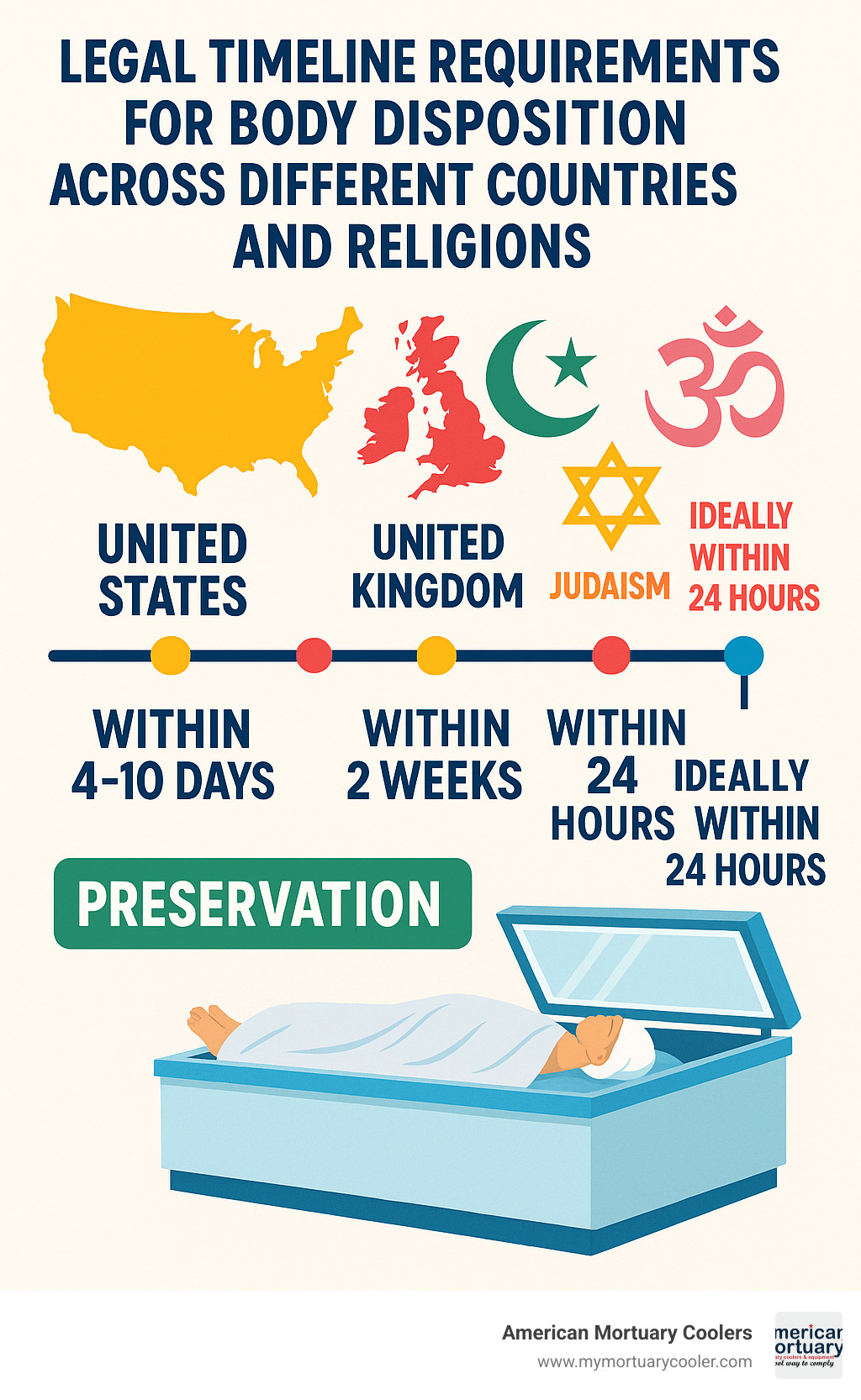
Supporting Cultural & Religious Practices While Meeting Laws
The intersection of faith traditions and legal requirements can be complex, but mortuary freezers help bridge these worlds with respect and dignity.
For Hindu families, the traditional preference for cremation within 24 hours can be challenging when relatives are scattered globally. A properly maintained mortuary freezer provides necessary preservation while honoring the importance of family presence for final rites.
Christian wakes often extend over several days, with open-casket viewings being central to the tradition. Refrigeration units can maintain viewable remains without heavy use of chemicals, creating a more natural appearance many families prefer.
In Muslim communities, where the janazah typically occurs as soon as possible after death, short-term refrigeration offers a respectful solution when immediate burial faces unavoidable delays.
Jewish traditions, which generally discourage embalming and emphasize prompt burial, often find refrigeration to be an acceptable temporary measure that respects religious preferences.
Health & Safety Protocols for Staff and Visitors
Mortuary freezers play a crucial role in creating safe environments for both staff and visitors. These units contain biohazards, reduce airborne pathogens, and minimize chemical exposure compared to traditional embalming.
For funeral professionals, proper PPE, consistent hand hygiene, and regular unit maintenance create a safe working environment. The controlled environment makes remains handling safer and more dignified for staff.
Visitors benefit from these safety measures too. Families can focus on their emotional needs during viewings without worrying about exposure risks. Simple precautions like hand hygiene ensure these moments remain safe for everyone present.
Legal Considerations
The legal framework governing mortuary freezers varies significantly by location. Understanding these regulations is essential for providing both compliant and compassionate care.
In most areas, facilities using mortuary freezers must register with local authorities and maintain proper documentation for each person in their care. Death certificates, transportation permits, and sometimes specific refrigeration logs are required by law.
India's system often requires a No Objection Certificate from police authorities before refrigeration, while the UK's Human Tissue Authority mandates specific temperature monitoring protocols. In the United States, regulations typically come from multiple sources—state funeral boards, local health departments, OSHA workplace standards, and CDC guidelines all play a role.
The World Health Organization provides valuable guidance, particularly for special circumstances like infectious disease cases or disaster response, where proper refrigeration becomes even more critical for public health.
Comparing Preservation Methods: Mortuary Freezers vs. Ice Boxes vs. Embalming
When it comes to preserving our loved ones after they've passed, funeral professionals have several options to consider. Each method has its own strengths and appropriate applications.
| Feature | Mortuary Freezers | Ice Boxes | Embalming |
|---|---|---|---|
| Preservation Duration | 4-6 weeks (refrigerated) Months to years (frozen) |
24-48 hours | Weeks to months |
| Temperature Range | 2-8°C (standard) -2 to -30°C (forensic) |
Variable, typically 0-8°C | Room temperature |
| Chemical Use | None | None | Formaldehyde, phenol, others |
| Viewing Capability | Glass-top models allow viewing | Limited | Excellent |
| Cost Range | $5,000-$30,000 (purchase) $200-$500 (rental) |
$100-$300 (rental) | $500-$1,500 (procedure) |
| Environmental Impact | Energy consumption only | Minimal | Chemical disposal concerns |
| Religious Acceptability | Widely accepted | Widely accepted | Restricted in some faiths |
| Portability | Limited (except for portable units) | Good | N/A (procedure) |
When to Choose Each Method
Mortuary freezers shine when families need more time. They're particularly valuable in communities with diverse religious traditions where embalming might not align with spiritual practices. These units create a peaceful middle ground - preserving dignity without chemicals while allowing families the precious gift of time.
Ice boxes serve as effective short-term solutions. They're perfect for brief periods when a permanent facility isn't available or when disaster response teams need immediate, portable options.
Embalming offers unique benefits, particularly when open-casket viewings are an important part of the farewell process. This traditional approach allows for detailed restoration work and creates stability for long-distance transport.
Environmental and Regulatory Considerations
From a compliance standpoint, mortuary freezers offer a gentler footprint than some alternatives. Staff members appreciate the reduced chemical exposure compared to traditional embalming processes. The broad acceptance of refrigeration across diverse faith traditions makes these units versatile additions to any funeral home serving multicultural communities.
Operating mortuary freezers comes with responsibilities: maintaining proper temperature logs, ensuring backup power systems are operational, keeping detailed maintenance records, and providing appropriate ventilation.
Most regulatory frameworks explicitly recognize refrigeration as a valid preservation method. This legal clarity has contributed to the growing popularity of mortuary freezers in modern funeral service, as directors appreciate both the practical benefits and the straightforward compliance requirements.
Renting or Purchasing a Mortuary Freezer: Costs, Availability & Maintenance
Deciding whether to rent or purchase a mortuary freezer is a significant decision for any funeral home. Your choice will depend on your case volume, budget, and available space.
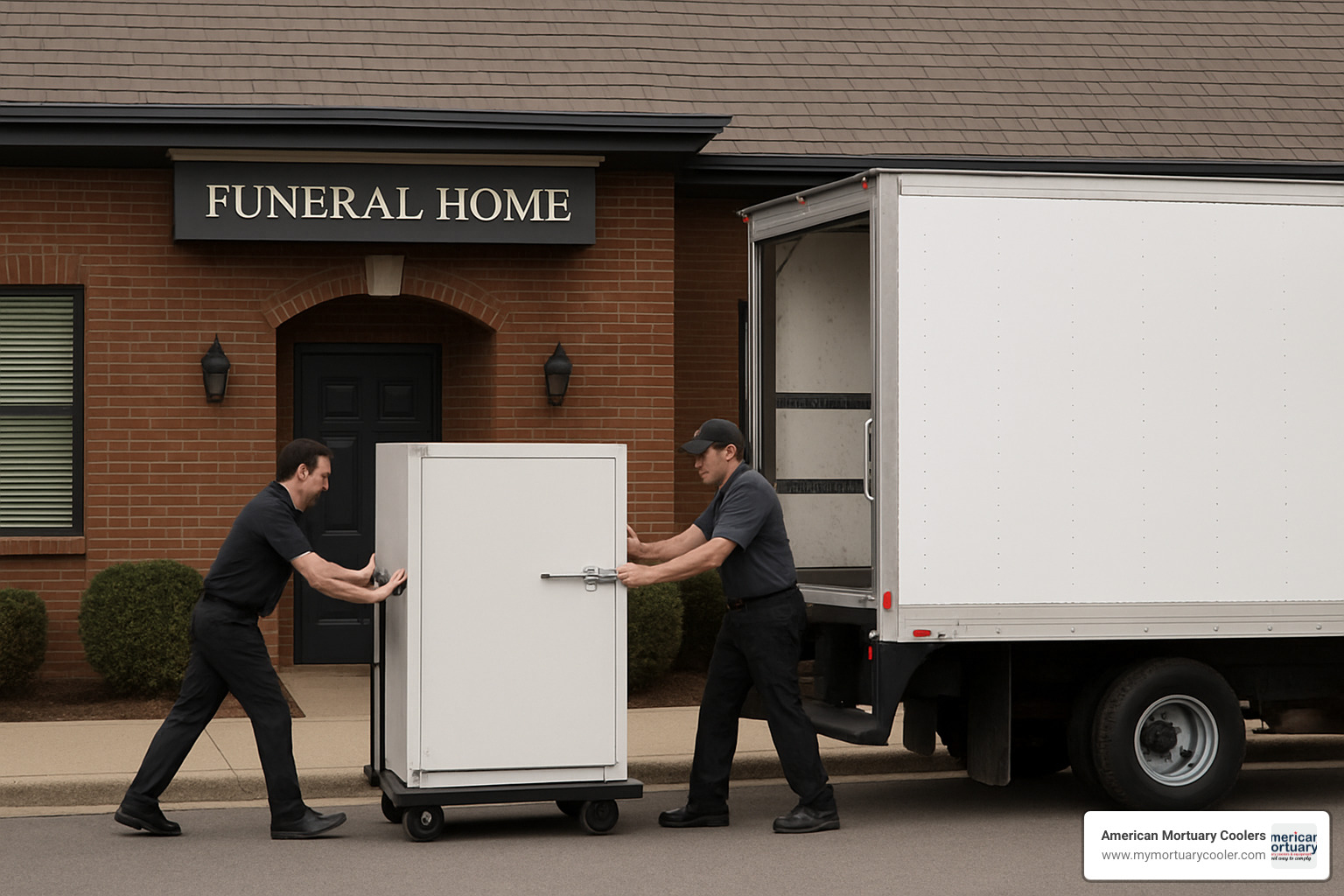
Procedures for Rental or Use
When you need a mortuary freezer quickly, the rental process is straightforward but requires attention to detail. Most service providers have streamlined the process to support you during sensitive times.
The rental journey typically begins with a phone call to a reputable provider. Documentation is an important part of the process. You'll need to provide your facility identification and licensing information, along with the death certificate or hospital release. Some jurisdictions also require a Police No Objection Certificate (NOC).
Once paperwork is complete, delivery typically happens within 2-4 hours in urban areas. Technical setup, temperature calibration, and operational training are usually included with delivery.
Rental periods are flexible, usually lasting until funeral services are completed and the body is transferred for final disposition. At American Mortuary Coolers, rental fees can be applied toward purchase if you decide the unit meets your long-term needs.
Cleaning, Disinfection & Ongoing Upkeep
Proper maintenance isn't just about equipment longevity – it's about dignity and respect for the families you serve. A well-maintained mortuary freezer ensures reliable operation when you need it most.
After each use, disconnect the power and allow the unit to reach room temperature. Then, remove and clean all trays and body boards with hospital-grade disinfectant. Clean interior surfaces with appropriate sanitizing agents and dry thoroughly. Finally, reconnect power and verify the temperature stabilizes before preparing for the next use.
Regular maintenance should include monthly checks of door seals and gaskets, quarterly inspection of refrigerant levels and connections, and annual professional service of the compressor and electrical systems.
Annual maintenance typically runs between $800-$1,500, while a compressor replacement (if needed) costs around $1,500-$3,000. This preventative care significantly extends your equipment's lifespan and helps avoid emergency repairs.
Alternatives & Emerging Technologies
While traditional mortuary freezers remain the industry standard, exciting developments in preservation technology offer new options for forward-thinking funeral homes.
Dry ice preservation provides cooling without electrical requirements. Alkaline hydrolysis (sometimes called aquamation) represents a water-based alternative to cremation. For those still using embalming, green embalming fluids offer formaldehyde-free alternatives that reduce environmental impact.
At American Mortuary Coolers, our newest models feature energy-efficient compressors that reduce power consumption by up to 30% compared to older units – good for both utility bills and the environment.
Frequently Asked Questions about Mortuary Freezers
How quickly should a body be placed in a mortuary freezer after death?
Ideally, refrigeration should begin within 24 hours of death, especially in warmer climates. Several factors influence this timeline: ambient temperature plays a crucial role, and the cause of death can affect how quickly preservation should begin.
In hospital settings, staff typically move the deceased to refrigeration within 2-4 hours after death is pronounced. When someone passes at home, the timeline depends on when funeral professionals can arrive and transport the deceased to proper facilities.
Prompt refrigeration makes a remarkable difference in preservation outcomes. Each hour at room temperature can potentially reduce the effective preservation period by several days, which ultimately impacts the family's ability to gather and say goodbye properly.
Is special permission required to store a body in a private residence freezer box in India?
Yes, keeping a loved one at home using a mortuary freezer in India requires several official permissions:
- A No Objection Certificate (NOC) from local police authorities
- A properly registered death certificate with municipal authorities
- Written permission from building management or housing society (for apartments)
- Health department clearance in some municipalities
These requirements vary significantly across India. In Delhi, for example, the municipal corporation requires notification if a body will remain at home for more than 12 hours, even with proper refrigeration.
Beyond paperwork, families should consider practical matters like ensuring uninterrupted power supply and respecting neighbors' concerns in shared living spaces.
Can mortuary freezers be used for international repatriation flights?
Yes, though there's quite a bit involved in the process. Before international transport, bodies typically need to be embalmed according to international standards, placed in a hermetically sealed container, and accompanied by extensive documentation.
The paperwork requirements include a death certificate, embalming certificate, export/import permits, consular authorization, and a non-contagious disease certificate.
The International Air Transport Association (IATA) provides specific guidelines that airlines follow for human remains transport. Most international repatriations use a combination of initial preservation in mortuary freezers, professional embalming for transport, specialized air-transport containers, and climate-controlled vehicles for ground transportation.
Conclusion
Find the essential role of mortuary freezers in preserving bodies for funeral services and the legal considerations surrounding them. Learn more now! Throughout our exploration of these specialized units, we've seen how they've transformed modern funeral service, offering families and funeral professionals more dignified and flexible options during difficult times.
Mortuary freezers do more than preserve remains. They create space for grief, allowing families precious time to gather from across the country, make thoughtful arrangements, and say proper goodbyes without rushing through important decisions.
Beyond practical aspects, these units support a diversity of religious and cultural practices. Whether it's a Hindu family needing time for relatives to arrive before cremation, or a Jewish community requiring a non-invasive alternative to embalming, mortuary refrigeration offers solutions that honor these deeply held traditions while meeting necessary health regulations.
At American Mortuary Coolers, we take pride in being part of this important work. Our Tennessee craftsmen build each unit with funeral professionals' specific needs in mind. We understand that durability matters when you're serving families day after day, which is why we use commercial-grade stainless steel and components designed to withstand years of continuous operation.
For funeral professionals considering adding or upgrading mortuary refrigeration, start with a thorough assessment of your specific needs. Think about your typical case volume, available space, and the particular religious communities you serve. Understanding local regulations is equally important, as requirements can vary dramatically between jurisdictions.
Remember to plan for both the expected and unexpected. A reliable backup power system might seem like an unnecessary expense—until the first time a summer storm knocks out electricity for hours. Similarly, regular maintenance prevents costly emergency repairs and ensures your unit is always ready when families need it most.
Our team at American Mortuary Coolers delivers custom solutions nationwide to all 48 contiguous states. Whether you're opening a new facility or upgrading aging equipment, we're here to help design the perfect refrigeration solution for your unique situation.
For more information about custom cooler solutions for your facility, contact American Mortuary Coolers today.
















